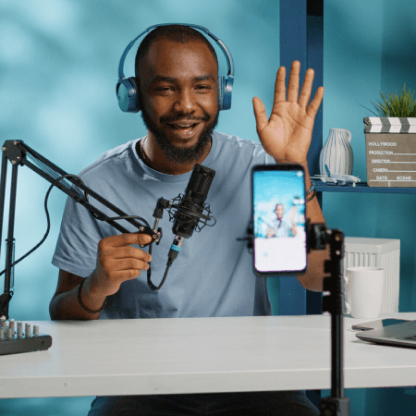Are you feeling overpowered by the circus of remote hiring? We’ve all been there: juggling countless programs, struggling with time zone issues, and dreading the notion of seeing another phone screen. Even before remote work became commonplace, traditional hiring practices were starting to show their age, and, to be honest, adding video interviews just seemed like one more level of difficulty.
But hold on! Asynchronous one-way video interviews are a video interview’s revolutionary cousin, so don’t write off video interviews just yet. You did really read correctly. No uncomfortable in-person meetings, no stressful scheduling—just applicants showing off their skills when it’s convenient for them, and you taking your time going over everything. Seems too wonderful to be true? It’s not. Furthermore, one-way video interviews might be the covert tool you’ve been looking for if you’re a reluctant HR manager like you.
Curious? Continue reading to see how this creative method may expedite your remote hiring process, provide you with access to a wealth of applicant information, and free up your valuable time to concentrate on what really matters—finding the ideal candidate for your team. Prepare to bid your hiring woes a fond farewell and welcome to a more productive, efficient, and—dare we say it—enjoyable method of discovering your next big star.
The Power of One-Way Video Interviews
Conventional hiring practices are finding it difficult to stay up in today’s remote-first society. In-person interviews can need considerable travel and scheduling difficulties, and setting up phone screenings across time zones may be a logistical headache. Introducing one-way video interviews, a cutting-edge approach that is completely changing the hiring process.
However, the idea can cause some anxiety for HR managers who are reluctant to adopt video interviews. They could wonder, “Won’t it add more complexity?” “What about the human connection?” Don’t worry, though; one-way video interviews provide a special combination of adaptability, effectiveness, impartiality, and insightful applicant feedback without compromising the human element.
Embracing Flexibility for a Smoother Experience:
The asynchronous nature of one-way video interviews is one of its main advantages. This eliminates the need for applicants to coordinate time zones and juggle schedules since they may record their replies whenever it is convenient for them. Consider a bright candidate who lives abroad. With one-way video interviews, they may demonstrate their qualifications without worrying about fitting into your hectic schedule.
This freedom also applies to recruiters. The days of cramming many phone screens into an already full schedule are long gone. You may review pre-recorded interviews at your own pace and incorporate them into your current process by doing so. This increased adaptability not only relieves tension but also makes it possible to give each applicant more careful thought. For more information, see Interviewing Candidates for Employment.
Saving Time and Effort:
It’s true that the typical hiring process might take a very long period. Phone interviews frequently go longer than planned, and in-person interviews need extra planning. A pleasant diversion from this time pressure is provided by one-way video interviews. You can screen more candidates in less time using pre-recorded replies since they cut down on review times. Compare the amount of time it takes to examine 10 pre-recorded interviews in an hour versus the same number of 30-minute phone screenings. That saves a great deal of time!
Moreover, efficiency is further increased by the capacity to examine interviews in batches. To compare candidates fairly, group comparable questions together and watch them back-to-back. This simplified method frees you from the burden of scheduling conflicts and administrative difficulties so you can concentrate on finding the perfect fit. Read Asynchronous Work Can Fuel Creativity for more information.
Standardized Screening:
Any employment process can include unconscious bias, but one-way video interviews can help lessen its impact. One way to establish a uniform screening environment is to ask all candidates the identical pre-recorded questions. This guarantees that everyone, regardless of personal circumstances that can affect an in-person contact, gets an equal opportunity to highlight their abilities and expertise.
Furthermore, the replies from each candidate may be evaluated more objectively because to the standard format. Without being influenced by extraneous elements like looks or the interview environment, you can concentrate on the substance of their responses, their interpersonal abilities, and how they conduct themselves on video. See How can you prevent unconscious bias in hiring for more details.
Unveiling the Human Element:
One-way video interviews provide a more in-depth understanding of a candidate’s personality and communication abilities than any resume or phone screen could, despite their first seeming impersonal nature. You may evaluate a candidate’s entire mood, body language, and eye contact by watching them on video. This gives you important information about their professionalism, self-assurance, and potential fit with your team. Read Staff Advisors’s article about Why We Prefer Phone Calls Over Video Interviews.
In addition, applicants frequently reply to recorded questions at their own pace with greater ease and clarity. This may result in more sincere and perceptive responses that highlight facets of their character and way of thinking that might not come through in a more conventional interview situation. Check the Benefit of Using Video Interviews as a Hiring Tool for more information.
Cost-Effectiveness:
Even while one-way video interviews have many advantages beyond financial savings, it’s important to note that they will have a favorable effect on your hiring budget. Substantial cost savings can result from cutting the travel costs and the administrative work involved in setting up and carrying out interviews.
Furthermore, recruiting choices may be made more quickly because to the efficiency improvements from batch reviewing and pre-recorded films, which can ultimately result in cost savings. See Pros and Cons of One-Way Video Interviews with Candidates.
In an era where hiring remotely comes first, one-way video interviews are more than just a trend. They mark a paradigm shift in the way we do hiring. Through the provision of flexibility, efficiency, standardized screening, enhanced applicant insights, and even cost savings, they enable recruiters and candidates to have a more seamless and productive hiring process. Thus, consider using one-way video interviews to update your employment process and unlock the potential that lies inside your candidates. The good effect they have on the overall hiring process may surprise you.
Embracing One-Way Video Interviews: A Practical Guide for Forward-Thinking Recruiters
The changing nature of the modern workplace demands that hiring process also change in tandem. Although there is no denying the intrinsic worth of conventional employment practices, there is a clear paradigm shift in favor of digital alternatives. With its unique combination of effectiveness, adaptability, and equity, one-way video interviews become a powerful force influencing the direction of talent acquisition in the future.
Nevertheless, adopting a new technology might cause anxiety, especially for seasoned HR professionals used to well-traveled routes. This part functions as a thorough manual, providing doable and feasible tactics to help your company deploy one-way video interviews successfully and smoothly.
Initiating the Journey:
A controlled and planned strategy would be to start a pilot program rather than a company-wide revamp. Before implementing the process more widely, choosing a single position with a reasonable candidate pool enables familiarization with the platform of choice, identification of possible issues, and process modification.
Consider this first stage to be similar to a training session for both your internal staff and prospects. Encourage honest dialogue and input from all parties concerned. This trial program will boost your confidence and provide insightful feedback to improve your future video interview processes.
Fostering Transparency:
Candidates should be provided with comprehensive information about the structure and requirements of the one-way video interview process. Give them a detailed explanation of the platform they will be using, the kinds of questions they may expect, and the length of the recording right away.
Candidate nervousness can be further reduced by offering practice ideas and thorough instructions. Giving kids instances of both successful and unsuccessful reactions encourages them to plan ahead. Recall that encouraging open communication increases confidence and guarantees that everyone involved has a good time.
Quality over Quantity:
Asking a ton of difficult questions to applicants might work against them. Rather, give precedence to succinct and topical questions that evaluate the applicant’s abilities and background in relation to the particular position. Candidates are able to respond with clarity and insight while simultaneously saving time.
To get detailed information and particular instances, think about using a mix of closed-ended and open-ended inquiries. Developing a sophisticated grasp of the applicant’s reasoning and problem-solving skills is the ultimate objective.
A Platform that Empowers:
The effectiveness of your one-way video interviews is greatly impacted by the platform’s user experience. Invest in a dependable, safe, and user-friendly platform. It should have smooth interaction with your current applicant tracking system, straightforward recording instructions, and high-quality video and audio capabilities.
During the choosing process, factors including solid data security, extensive technical assistance, and ease of access should be carefully taken into account. For recruiters and applicants alike, a well-selected platform may expedite the entire process, increasing productivity and cultivating a favorable experience.
The Power of Feedback:
Even for applicants who choose not to proceed, giving them constructive criticism shows professionalism and creates a good image that sticks. Give a succinct summary of their advantages and disadvantages, together with practical recommendations for upcoming projects.
Additionally, proactively seek out candidates’ opinions about their one-way video interview experience. This priceless information will help you fine-tune your strategy and make sure that subsequent iterations are even more fruitful. Making the most of this creative hiring process requires constant development.
Taking a fearless leap of faith is not necessary to embrace one-way video interviews. You may successfully negotiate this change and reap its many benefits by implementing a pilot program, encouraging open communication, putting quality before quantity, investing in a top-notch platform, and providing helpful criticism. Recall that there are several benefits to this creative strategy, such as enhanced applicant experience, cost savings, higher efficiency, and more equitable screening procedures. Launch the process, take the initial step, and see the great effects it may have on your overall talent acquisition process.

Tips:
- Create a scoring guide: Establish a uniform grading scheme so that candidate answers may be assessed impartially.
- Educate your group: Make sure all participants are aware of the one-way video interview procedure and how to efficiently evaluate and grade answers.
- Encourage using video interviews in your work: It is important to make it clear in your job advertisements and on your company website that you use one-way video interviews.
- Remain educated: Keep up with the newest developments and industry best practices in the field of technology and methodology for video interviews.
One-Way Video Interviews for Global Tech Startups

A leading supplier of open-source collaboration software GitLab employs a completely remote staff. Traditional phone interviews presented several difficulties due to the team’s geographical dispersion over 68 countries, time zone differences, scheduling difficulties, and the inability to evaluate soft skills. HireVue is a platform for one-way video interviews that GitLab deployed in 2018 to expedite their employment process worldwide.
Here’s how one-way video interviews transformed GitLab’s hiring:
- Enhanced Efficiency: GitLab was able to screen more candidates in less time by reviewing pre-recorded videos, which eliminated time zone barriers and opened up a wider pool of talented candidates, regardless of location.
- Standardized Screening: The use of pre-recorded questions ensured that all applicants would be evaluated fairly and consistently, saving money on travel and administrative costs.
- Improved Candidate Experience: The flexibility of recording from home and the ability to review the material at your own pace improved candidate satisfaction.
“One-way video interviews have been instrumental in building our globally distributed team,” GitLab CEO Sid Sijbrandij explains. “They have made it possible for us to locate the greatest talent more quickly and effectively, wherever they may be. Thanks to this creative strategy, we’ve noticed a noticeable increase in the caliber of hiring and a more varied team.” For more information, see GitLab’s Culture Handbook.
The Power of One-Way Video Interviews
To sum up, one-way video interviews are not a magic bullet and do not seek to take the place of the indispensable importance of face-to-face communication during the employment process. Rather, they are an effective means of improving the first screening phase, which saves time, broadens perspectives, and guarantees a more equitable and productive pool of talent.
Envision HR managers equipped to engage with eligible applicants worldwide, unhindered by scheduling conflicts and logistical obstacles. Imagine a merit-based, diversified workforce that isn’t constrained by geography or unconscious prejudice. These opportunities are unlocked via one-way video interviews, which present a revolutionary method for the contemporary hiring environment.
Thus encourage HR leaders to adopt this innovation. Do experiments, investigate, and observe directly the beneficial effects. Discover how using video interviews may improve efficiency, increase the number of candidates in your pool, and eventually assist you in finding the real gems who will lead your company to success.




